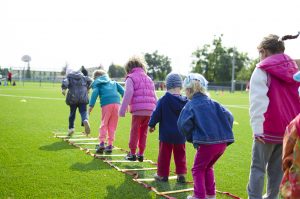
Every October is recognized as Children’s Health Month, which reminds us of the importance of protecting our children’s health in places where they live, play, and learn. Environmental hazards are the main topic of this month, and how we can protect our children from the harmful things around us. From their earliest stages of development through puberty, children are vulnerable to exposure to contaminants such as lead. They are particularly vulnerable because their bodies are small and still developing. It’s important to be aware of what can affect your children, and keep them safe where they live, play, and learn.
Live
In awareness of Children’s Health Month, it’s imperative to your children to know what can negatively affect them right at home. Harmful contaminants in the form of fertilizers and lawn/garden chemicals can affect children that it comes into contact with. Children’s age-appropriate behavior exposes them to potential hazards, especially when they learn to crawl. Being down on the ground puts them in close contact with the chemicals that can be most harmful. The following types of pollution can be found in the home and can have an impact on the health of your children.
Indoor air pollution can be broken down into 2 categories: biologic and chemical. Biologic pollutants include bacteria, molds, viruses, animal dander, cat saliva, dust, mites, cockroaches, and pollen. The U.S. population, on average, spends as much as 90% of its time indoors. Consequently, allergens and irritants from the indoor environment may play a significant role in triggering asthma episodes. Several indoor environmental asthma triggers are biologic pollutants. Chemical pollutants that can be found in the home include Carbon Monoxide, O3, tobacco smoke, VOCs, Radon, pesticides, asbestos, and lead. Any of these things can cause negative health effects. It’s important to know what they are, how they can affect your children, and how to manage them safely.
Play
Being able to play in a safe, hazard-free environment should be a right every child has. Playing and having fun is a major part of childhood and can even help with social and developmental skills. Unfortunately, there are a lot of harmful environmental hazards in the air, water, and soil that can have detrimental effects. This awareness of these things is so important. According to the CDC, there are initiatives that provide communities with resources to identify and reduce environmental hazards. For example, soilSHOPS are free community events where people bring soil from their yards for ATSDR to screen for things like lead. ATSDR environmental health scientists and health educators also give presentations and answer people’s questions at these events to reduce and prevent exposure to lead in the community. Know how to protect your kids so they can safely enjoy playing outside or on their playground.
Learn
Your child’s early development years are essential. Because their bodies are still growing, children are at greater risk if they are exposed to environmental contaminants. Children are more susceptible to harmful effects in their younger years and here’s why:
- Children breathe more air, drink more water, and eat more food per pound of body weight than adults.
- Children are more likely to put their hands in their mouths.
- A child’s body may not be able to break down and get rid of harmful contaminants that enter their body.
- Health problems from an environmental exposure can take years to develop. Because they are young, children have more time to develop health conditions and diseases than adults who are exposed later in their life.
For More Information
It’s important to know about environmental hazards and how we can work to help children live safer, play safer, and learn safer. This Children’s Health Month, take the time to make yourself aware of these things, and do your research. You can also visit the CDC to find out more information.
If you have additional questions about your child’s health, call (919) 896-7066 to talk to a team member about making an appointment.
At HealthPark Pediatrics, the health and safety of our staff and patients is our top concern. We are taking steps to ensure that you and your child will be safe while visiting our office. This includes using a separate entrance for sick visits, limiting the number of staff and physicians, observing social distancing guidelines, and offering telemedicine visits.



